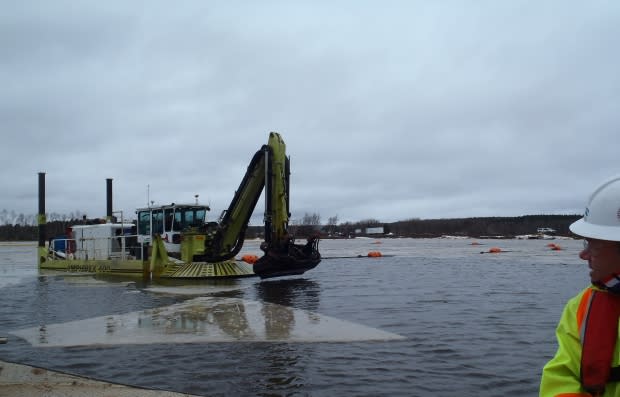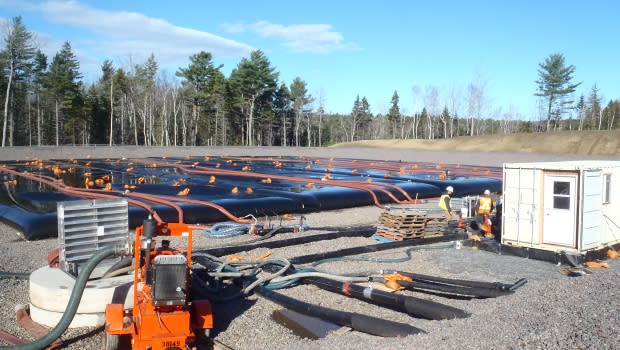Boat Harbour cleanup expected to start in 2021
The start date to clean up Boat Harbour, Nova Scotia's biggest environmentally contaminated site, may be pushed back by a year to 2021.
The remediation project at the pulp mill effluent facility, and its timetable, is separate from a new treatment system that is being proposed by Northern Pulp to replace Boat Harbour.
But the cleanup is facing its own regulatory and environmental challenges.
"It's a big, complex problem," said Ken Swain, a project leader. "It's a pretty complicated solution."
Nova Scotia on the hook
Since 1967, lagoons adjacent to the Pictou Landing First Nation have received tens of millions of litres of wastewater effluent per day from a nearby pulp mill.

The Boat Harbour treatment facility is owned by the provincial government, which is on the hook for the cleanup once the facility closes. The cost is forecast at $217 million.
Not the pipe in the Northumberland Strait project
Controversy swirls over where the mill's latest owner, Northern Pulp, plans to discharge treated effluent when Boat Harbour closes.
Swain said the remediation is proceeding on the assumption Boat Harbour will close by Jan. 31, 2020 — as required under the 2015 Boat Harbour Act — even if the Boat Harbour cleanup is not ready to proceed.
"We're probably gonna have to push that back," Swain said.
Cleanup expected to start in 2021
Swain points to the environmental assessment process. The cleanup project will undergo a Tier II provincial environmental assessment, which includes an independent review panel and public hearings. It can last up to 275 days.
Last week, the province submitted its plans to the Canadian Environmental Assessment Agency. The agency will decide in February whether the project should undergo a federal assessment.
Procurement will follow regulatory approval and take months longer.
"So what we would probably see in that instance is not being able to have the full-scale implementation started until perhaps early 2021," Swain said.
The Boat Harbour cleanup plan
The plan is to dredge up to a million cubic metres of contaminated, watery sediment and pipe it to a pad where water will be removed for treatment.
Up to 500,000 cubic metres of solids will be moved to an existing and expanded containment cell on site.
"The biggest technical challenge is effectively removing that material off the bottom of Boat Harbour," said Swain.
"We want to figure out the most efficient and effective way of getting the lens of contaminated sludge off the bottom and taking as little as possible of the clean underlying harbour bottom."
Why a key pilot project was suspended
They are still looking for the right solution.

Last October, dredging began to test techniques, but the pilot project was suspended in December because cold weather froze pipes.
The pilot project will resume sometime in April or May.
What's in raw mill effluent?
In May 2017, the province awarded a $6.7-million contract to GHD, an international consulting firm, to come up with the detailed plan for the cleanup.
The plan submitted to the federal government on Jan. 7 is from GHD and Nova Scotia Lands, a provincial agency charged with environmental cleanup.
GHD determined the nature and extent of contamination.
It also compared raw effluent with provincial and federal standards.
"Results indicated both PCBs and dioxins and furans were below the applicable criteria, while metals exceed the marine criteria for barium, boron, cadmium, copper, lead, mercury, and zinc. Metals parameters reported to exceed the Provincial human health criteria were sodium and vanadium," the project description stated.
The good news
The contaminated sludge is 10 per cent solids and 90 per cent water. The goal is remove between 50 to 70 per cent of the water.
The good news so far is water removed from the sludge is relatively clean.
"It will need some treatment, but not to the extent that we initially were envisioning," Swain said.
"We know we have to deal with in excess of five million cubic metres of water during the full-scale implementation of the remediation, which is several thousand Olympic-size swimming pools. So it's a large volume, a big-cost driver."
How the forecast cost has increased
In 2018, the cost of the full cleanup was estimated at $217 million.
It has risen steadily since the initial estimate of $52 million in 2015, $88 million in 2016 and $133 million in 2017.
A new forecast is expected in mid-2019 after the pilot project is completed.
The goal of the cleanup is to return Boat Harbour to a tidal estuary — its original condition in 1967 — which means removing all the contaminated sediment.
"We'll have to be clean," said Swain.
"At the end of the day what goes out needs to be in compliance with the Fisheries Act. So we cannot release any deleterious substances into the environment so we've got to get it all."

